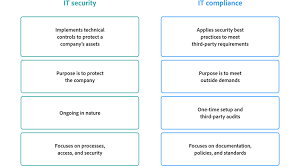The Importance of IT Compliance in Today’s Business Environment
In today’s digital age, businesses rely heavily on technology to operate efficiently and effectively. With the increasing amount of sensitive data being stored and processed electronically, ensuring compliance with IT regulations has become a critical aspect of business operations. IT compliance refers to the adherence to laws, regulations, and standards that govern the use and management of information technology within an organisation.
Why is IT Compliance Important?
Compliance with IT regulations is essential for several reasons:
- Data Security: Compliance helps protect sensitive data from breaches and cyber-attacks by implementing security measures and best practices.
- Legal Requirements: Failure to comply with IT regulations can result in legal consequences, fines, and damage to a company’s reputation.
- Risk Management: Compliance helps organisations identify and mitigate risks associated with data breaches, system failures, or non-compliance.
- Business Continuity: By ensuring compliance with IT standards, businesses can maintain operational continuity and prevent disruptions that could impact productivity.
Challenges of IT Compliance
While the benefits of IT compliance are clear, many organisations face challenges in maintaining compliance due to factors such as:
- Complexity: The constantly evolving regulatory landscape makes it challenging for businesses to keep up with changing requirements.
- Resource Constraints: Limited resources, including budget and expertise, can hinder efforts to implement robust compliance measures.
- Data Protection: Ensuring the security and privacy of data while complying with regulations poses a significant challenge for many organisations.
Best Practices for Achieving IT Compliance
To overcome these challenges and achieve effective IT compliance, organisations can adopt the following best practices:
- Risk Assessment: Conduct regular risk assessments to identify potential vulnerabilities and threats to data security.
- Policies and Procedures: Establish clear policies and procedures that outline how data should be handled, stored, and protected.
- Training and Awareness: Provide ongoing training to employees on data security best practices and their role in maintaining compliance.
- Audit and Monitoring: Implement regular audits and monitoring processes to ensure compliance with regulations and identify any non-compliance issues promptly.
In Conclusion
In conclusion, IT compliance is crucial for businesses looking to safeguard their data, mitigate risks, and maintain operational continuity. By prioritising compliance efforts through effective policies, training, monitoring, and auditing practices, organisations can enhance their cybersecurity posture and build trust with customers. In today’s increasingly regulated business environment, investing in IT compliance is not just a legal requirement but a strategic imperative for long-term success.
Understanding IT Compliance: Fundamentals, Examples, Definitions, and Roles
- What are the basics of IT compliance?
- What is an example of IT compliance?
- What is the meaning of IT compliance?
- What is the role of IT compliance?
What are the basics of IT compliance?
Understanding the basics of IT compliance is essential for any organisation looking to secure its digital assets and adhere to regulatory standards. At its core, IT compliance involves aligning IT practices with relevant laws, regulations, and industry standards to protect data integrity, confidentiality, and availability. Key elements of IT compliance include implementing robust security measures, conducting regular risk assessments, maintaining detailed documentation of IT processes, and ensuring that employees are well-trained in data security protocols. By establishing a solid foundation in these fundamental aspects of IT compliance, businesses can enhance their cybersecurity posture and demonstrate a commitment to safeguarding sensitive information.
What is an example of IT compliance?
An example of IT compliance is the implementation of the General Data Protection Regulation (GDPR) within an organisation. GDPR is a set of regulations that govern how businesses handle and protect personal data of individuals within the European Union. To achieve compliance with GDPR, organisations must ensure that they have proper data protection measures in place, obtain explicit consent for data processing, appoint a Data Protection Officer (DPO), and report data breaches within a specified timeframe. By adhering to GDPR requirements, businesses demonstrate their commitment to protecting customer data and complying with legal standards regarding privacy and security.
What is the meaning of IT compliance?
IT compliance refers to the adherence to laws, regulations, and standards that govern the use and management of information technology within an organisation. It encompasses ensuring that IT systems, processes, and practices meet the necessary requirements set forth by regulatory bodies to protect data security, maintain operational integrity, and mitigate risks. Essentially, IT compliance is about aligning IT practices with legal mandates and industry best practices to safeguard sensitive information, uphold business ethics, and demonstrate a commitment to responsible data management.
What is the role of IT compliance?
The role of IT compliance is to ensure that organisations adhere to laws, regulations, and industry standards governing the use and management of information technology. By following IT compliance guidelines, businesses can protect sensitive data, mitigate risks, and maintain operational continuity. IT compliance helps establish a framework for data security, privacy protection, and risk management within an organisation. It also plays a crucial role in building trust with customers, avoiding legal consequences, and demonstrating a commitment to best practices in IT governance. Overall, the role of IT compliance is fundamental in safeguarding data integrity and fostering a secure and compliant business environment.

